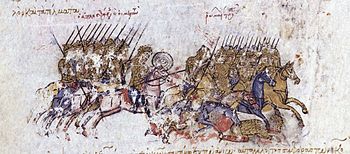Dvin (ancient city)
Khosrov III | |
| Founded | 4th century |
|---|---|
| Abandoned | 1236 |
Dvin (
The site of the ancient city is currently not much more than a large hill located between modern
Name
The earliest Armenian authors almost always give the name of the city as Duin (Դուին), while later authors such as Samuel of Ani spell it Dvin (Դվին), which is the form commonly used in scholarly literature.[4][b] The early medieval Armenian historian Movses Khorenatsi explains the name of Dvin as coming from a (Middle) Persian word (*duwīn) meaning 'hill'.[5][6][4] In the 5th-century Armenian history attributed to Faustus of Byzantium, the site is called "the hill [blur] in the plain of the Mecamōr called Duin" without reference to the meaning of the name.[7] According to Erich Kettenhofen, Khorenatsi's explanation of the name resulted from an incorrect interpretation of the aforementioned passage in Faustus's history.[4] Marie-Louise Chaumont writes that Khorenatsi's etymology became more accepted after Vladimir Minorsky pointed out the use of the word dovīn to mean 'hill' in Persian place names.[8]
History

The ancient city of Dvin was built by
After the fall of the
Although Armenia was a battleground between Arabs and Byzantine forces for the next two centuries, in the 9th century it still flourished. Frequent earthquakes and continued warfare led to the decline of the city from the beginning of the 10th century. During a major earthquake in 893, the city was destroyed, along with most of its 70,000 inhabitants.[10]

Following a devastating
In 1064, the
Dvin was the birthplace of
Cathedral of St. Grigor


Situated in the central square of the ancient city was the Cathedral of Saint Grigor. It was originally constructed in the 3rd century as a triple-nave pagan temple with seven pairs of interior structural supports. The temple was rebuilt in the 4th century as a Christian church, with a pentahedral apse that protruded sharply on its eastern side. In the middle of the 5th century, an exterior arched gallery was added to the existing structure. At the time that the cathedral was built, it was the largest in Armenia and measured 30.41 meters by 58.17 meters.[16]

Ornate decorations adorned the interior and the exterior of the building. The capitals of the columns were decorated with fern-like relief, while the cornices were carved in the design of three interlaced strands. The interior floor of the structure was made up of mosaic multi-colored soft-toned slabs in a geometric pattern, while the floor of the apse was decorated in the 7th century with a mosaic of smaller stone tiles representing the Holy Virgin. It is the most ancient mosaic depiction of her in Armenia. By the middle of the 7th century, the cathedral was rebuilt into a cruciform domed church with apses that protruded off of its lateral facades. All that remains of the cathedral today are the stone foundations uncovered during archaeological excavations in the 20th century.
Gallery
See also
Notes
- Arabic: دبيل, romanized: Dabīl or Doubil
- ^ In reformed Armenian orthography, both forms are rendered Դվին Dvin.
References
Citations
- ISBN 978-0-19-504652-6. Archivedfrom the original on 2020-10-23. Retrieved 2013-11-10.
- OCLC 1028910888.
- ^ https://www.behance.net/gallery/31097593/3D-model-of-ancient-capital-city-of-Armenia-Dvin
- ^ a b c Kettenhofen 1995.
- ^ Chaumont 1986, pp. 418–438.
- ^ Van Lint 2018.
- ^ Garsoïan 1989, pp. 75, 460.
- ^ Chaumont 1986.
- ^ Walker, C. Armenia-The Survival of a Nation, 2nd Ed., Routledge, London, ç1990, p. 28
- ISBN 978-0-521-02187-6. Archivedfrom the original on 2023-12-28. Retrieved 2020-10-31.
- ^ Ter-Ghewondyan 1976, p. 120.
- ^ Ter-Ghewondyan 1976, p. 122.
- ^ Minorsky 1977, pp. 53–56, 59–64.
- ISBN 978-0-8108-7450-3.
- ^ Lyons, Malcolm Cameron and David Edward Pritchett Jackson, Saladin: The Politics of the Holy War, (Cambridge University Press, 1982), 2.
- ISBN 978-0-8028-9016-0.)
{{cite book}}: CS1 maint: multiple names: authors list (link
Sources
- Vardanyan, Sergey (1995). Hayastani mayrakʻaghakʻnerě Հայաստանի մայրաքաղաքները [The Capitals of Armenia]. Yerevan: Apolon. pp. 109–121. ISBN 5-8079-0778-7.
- Harutyunyan, V. (1947). Architectural landmarks of Dvin. Academy of Sciences of Armenian SSR.
- Chaumont, M. L. (1986). "Armenia and Iran ii. The pre-Islamic period". In ISBN 978-0-71009-104-8.
- Kettenhofen, Erich (1995). "Dvin". In ISBN 978-1-56859-024-0.
- Minorsky, Vladimir (1977) [1953]. Studies in Caucasian History. Cambridge: Cambridge University Press. ISBN 0-521-05735-3.
- OCLC 490638192.
- The Epic Histories Attributed to Pʻawstos Buzand (Buzandaran Patmutʻiwnkʻ). Translation and commentary by ISBN 0-674-25865-7.)
{{cite book}}: CS1 maint: others (link - Van Lint, Theo (2018). "Dvin". In Nicholson, Oliver (ed.). ISBN 978-0-19-866277-8.


















